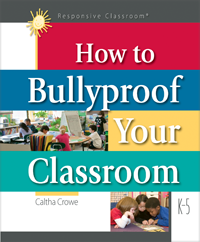Safe and Happy Classrooms
How to Bullyproof Your Classroom
by Caltha Crowe
(Responsive Classroom, 2012 – Learn more)
“Stop Bullying Before It Starts”…Sure, great advice, but how?
Caltha Crowe’s recently published book, How to Bullyproof Your Classroom, is a first-rate guide to establishing and maintaining an environment where students feel safe, secure, and receptive to learning. Crowe is an elementary school teacher with over 35 years in the elementary classroom, and her book is based both on personal experience and extensive research about evidence-based practices to prevent bullying.
Crowe is also a Responsive Classroom consulting teacher and author of several books, including Sammy and His Behavior Problems. Her articles about teaching and learning have appeared in the Responsive Classroom Newsletter and in Educational Leadership. She currently writes regularly for the Responsive Classroom blog.
Comprehensive and practical

To my relief, Crowe has not written a five-easy-steps kind of book. This comprehensive and practical resource guides educators as they try to balance the academic rigor of the classroom with student social and emotional development. As I began to read her exceptional book, I also realized that this wasn’t a book meant to be read in one or two sittings, but a book that encouraged the reader to go slow, reflect, and build on current practices.
What also impressed me was the relevancy of the scenarios in each chapter, and how her suggested strategies seamlessly incorporate anti-bullying messages into the established curriculum. For example, Crowe included a scenario from a Writers Workshop in which children helped a student revise a story titled “Fishing with My Dad.” In another instance, she provided an example of how to use a Readers Workshop book club lesson to reinforce positive interactions with students.
The importance of observation
Caltha Crowe stresses the importance of being a careful teacher observer. She suggests that we observe, assess, investigate, and reflect. She alerts us to not just note and react to blatant negative behaviors we may witness, but also to be watchful for more subtle behaviors, like hearing messages of …“she looked at me”… “he rolled his eyes at me,” signaling a current or potential problem. As acute teacher observers, we are able to circumvent many potential social problems.
Too often our lesson plans are directed only at trying to address academic content, and we lose track of Maslow’s hierarchy of needs. Before our students can achieve Maslow’s level of self actualization, the need for safety, belonging and self-esteem must be met. We may have the unrealistic expectation that all of our children will come to school with innate group processing skills. I agree with Crowe that these skills need to be modeled, explained, modeled, practiced, and modeled again through role play — all while we name and reinforce ideal behavior during this coaching process.
Not all of our children come to school knowing how to problem-solve in social situations. Many times the family structure is not strong and the children are not taught what we consider traditional values such as respect for each other and adults. To overcome this missing element of social behavior takes time. Crowe cautions the classroom teacher to remember that “bullyproofing” is not an initiative we introduce in the fall and then move on. And it’s also not a job reserved only for the classroom teacher. Every adult who intereacts with students needs to be involved in some way, and collaborating and communicating with other staff members and with parents needs to be a priority.
Interactive lessons worth your time
The second half of the book serves as an interactive guide to the reader, as Crowe coaches us through lesson ideas that are grouped by primary and upper elementary grade levels. Each series includes a developmental age guide and the lessons can be easily adapted to any classroom.
Believe me, the framework presented in this book is not “another thing I have to add to my already busy teaching schedule.” Catha Crowe is well-aware of a teacher’s burdens, and she’s provided us with lesson plans that include objectives, materials needed, vocabulary (great for Word Wall activities), step-by-step directions and follow-up activities.
Many of the mentor texts that she uses for the younger students, such as Odd Velvet and Chrysanthemum, may be familiar to children and are often included in Readers and Writers Workshop. Also cited in the Appendix are examples of children’s and professional literature as well as helpful websites.
As a teacher with many years of experience, I welcome this book. I would definitely recommend it to veterans and new teachers alike — and as a teaching text for student teachers. Finally, I think that Crowe’s masterful ability to integrate anecdotal stories, research based practices, and practical advice makes this book a MUST HAVE for every school’s professional library.
Linda Biondi is a fifth grade teacher at Pond Road Middle School in Robbinsville, New Jersey. She has written for Education World, the Responsive Classroom newsletter, and the ERIC Clearinghouse. She’s also the recipient of several grants that promote inquiry and a literacy enriched curriculum, and a consultant with the National Writing Project.



































